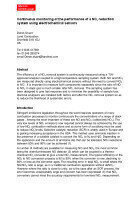Air Monitoring
Continuous monitoring of the performance of a NOx reduction system using electrochemical sensors
Oct 06 2014
Author: Derek Stuart on behalf of CEM
Abstract
The efficiency of a NOx removal system is continuously measured using a TüVapproved analyser coupled to a high-temperature sampling system. Both NO and NO2 are measured directly using electrochemical sensors without the need to convert NO2 to NO. It is important to measure both components separately since the ratio of NO to NO2 in stack gas is much smaller after NOx removal. The sampling system has been designed to give fast response and to minimise the possibility of sample loss. Identical analysers are installed both before and after the NOx removal system so as to reduce the likelihood of systematic errors.
Introduction
Stringent emissions legislation throughout the world requires operators of many combustion processes to monitor continuously the concentrations of a range of stack gases . Among the most important of these are NO and NO2 (collectively NOx). The very low levels of NOx emissions now required cannot always be achieved by the use of low-NOx combustion methods alone and so some form of scrubbing must be used to reduce NOx levels. Selective catalytic reduction (SCR) is widely used in Europe and is gaining increasing acceptance in the USA. This method uses ammonia injection in the presence of a suitable catalyst to convert the NOxto N2 and H2O. Depending on the application and the amount of ammonia slip that can be tolerated, NOx reductions between 80% and 90% can be achieved (1).
A number of methods are available for measuring NO and NO2, the most common being the chemiluminescent NO detector (2) which can be coupled to a thermochemical NOx converter to give a total NOx measurement. The typical efficiency of the NO2 to NO conversion process is 90 to 95% when the converter is new, declining to 80% or less as the converter ages. The resulting error in total NOx is small where the NO/NO2 ratio is large, as in a traditional combustion application without deNOx. However where the ratio is close to unity, as is the case after an SCR process, the error becomes unacceptably large and concern has been expressed (3) that NOx converters cannot meet the accuracy requirements for low-level NOx measurement.
For this reason, it is preferable to use a method which measures both NO and NO2 directly. Optical methods using ultraviolet spectroscopy (4) have proved successful but are rather expensive. In-situ infrared measurements of NO and NO2 are made difficult by the strong interference from water vapour at the principal absorption wavelength (5) whilst extractive IR measurements can suffer from baseline drift.
Digital Edition
IET 34.2 March 2024
March 2024
Gas Detection - Biogas batch fermentation system for laboratory use with automatic gas analysis in real time Water/Wastewater - Upcycling sensors for sustainable nature management - Prist...
View all digital editions
Events
Apr 18 2024 Shanghai, China
Apr 22 2024 Hannover, Germany
Apr 22 2024 Marrakech, Morroco
Apr 23 2024 Kuala Lumpur, Malaysia
Apr 23 2024 Kintex, South Korea















